
Mobileye and NIO Partner to Bring Level 4 Autonomous Vehicles in China and Beyond
Intel's Mobileye and Chinese maker of electric vehicles market NIO are engaging in a strategic collaboration on the development of highly automated and autonomous vehicles (AV) for consumer markets in China and other major territories.
As part of the planned cooperation, NIO will engineer and manufacture a self-driving system designed by Mobileye, building on its Level 4 (L4) AV kit. This self-driving system is targeting consumer autonomy and is engineered for automotive qualification standards, quality, cost and scale. NIO will mass-produce the system for Mobileye and also integrate the technology into its electric vehicle lines for consumer markets and for Mobileye’s driverless ride-hailing services. NIO’s variants will target initial release in China, with plans to subsequently expand into other global markets.
With NIO serving as its manufacturing partner, Mobileye’s self-driving system will be accessible to mass markets, further extending the reach of its AV technology to automotive customers on a global scale. The agreement also marks the first large-scale automaker partner supplying vehicles to Mobileye, as the company builds a global commercial robotaxi fleet.
For NIO, supporting the production and integration of Mobileye’s self-driving system aligns with its mission to provide smart electric vehicles. By joining with Mobileye, NIO aims to maintain its position in the premium electric vehicle market – with cars that deliver enhanced safety and functionality, powered by driver-assistance systems technologies and L4 autonomy.
Under the planned collaboration, Mobileye will provide NIO with the design of the self-driving system building on the Mobileye AV Series, a L4 AV kit comprised of the Mobileye EyeQ system-on-chip, hardware, driving policy, safety software and mapping solution. NIO will take on the automotive-grade engineering, integration and mass-production of Mobileye’s system for both consumer automotive markets and for Mobileye’s mobility-as-a-service (MaaS) applications. In addition to integrating the self-driving system into its vehicle lines, NIO will develop a specially configured variant of electric AVs that Mobileye will use as robotaxis, deployed for ride-hailing services in global markets.
The L4 AV kit is a driverless technology solution designed to be integrated in vehicles with autonomous capabilities that help minimize automobile accidents.
Mobileye’s AV Series offers necessary hardware to enable full autonomy in vehicles, including cameras, radars, lidars, cables, modem, GPS and additional mechanical components, all powered by the 5th generation EyeQ system-on-chip. It is purpose-built for low cost and low-power consumption, specifically for autonomous driving with deep learning and performance efficiency.
Mobileye’s proprietary reinforcement learning algorithms enable human-like driving skills for vehicle systems, which pair with the superhuman sight and reaction times possible through the technology’s sensing and computing platforms. Channeling Mobileye’s driving policy technology, vehicles equipped with the AV kit are able to negotiate with other human-driven vehicles on the road in complex situations.
Mobileye’s driving policy is complemented by its Responsibility-Sensitive Safety (RSS) model, which helps ensure an autonomous vehicle will make safe decisions. RSS is an open and transparent formal model that provides safety parameters for AV decision-making, formalizing common sense human-centered concepts of what it means to drive safely. While the planning behind driving policy gets vehicles from Point A to Point B, RSS helps keep them safe along the way.
The companies plan an initial release in China beginning in 2022, Mobileye President and Chief Executive Officer Amnon Shashua told Reuters in an interview on Monday.
Strategy for Driving Significant Growth
During an investor summit today at Mobileye headquarters in Jerusalem, Mobileye President and CEO Professor Amnon Shashua projected significant and sustained revenue growth for the next decade. The forecast was offered within a broader strategy update that included new data points across Mobileye’s lines of business, an expanded total available market (TAM) and new customer announcements. At the event, Intel CFO George Davis described Mobileye as one of the company’s strategic, data-centric growth opportunities, which is outperforming Intel’s initial expectations.
“Intel is participating in an expanded and increasingly data-centric TAM,” Davis said. “As one of Intel’s big bets, Mobileye is a critical part of Intel’s future and is already exceeding our expectations with ADAS revenue today that is funding the future of driverless cars.”
In the 2019’s third quarter, Mobileye achieved a record quarter with 20 percent revenue growth year over year driven by continued advanced driver-assistance systems (ADAS) momentum. Mobileye is now Intel’s fastest growing business on an annualized basis. The strength of Mobileye’s business today is largely attributable to an expanding ADAS market, while its future business will expand greatly with forays into data monetization and the nascent robotaxi market.
At the event today, Shashua laid out Mobileye’s strategic business pillars and provided deep-dives into Mobileye’s assets in computer vision, mapping and safety. Other disclosures included:
Revenue Today Through ADAS:
- By the end of 2019, Mobileye will have shipped more than 50 million EyeQ® chips since 2008.
- Today, Mobileye powers ADAS systems in 300 car models with 27 OEM partners.
- Eight out of 11 L2+ systems in production are based on Mobileye technology.
- Three major market design wins: 4 million new units with a major European OEM; a deal with the largest OEM in India – the second-fastest growing market for automobiles globally (after China); and two new wins with leading Chinese OEMs.
Also announced today, Mobileye and RATP Group (Régie Autonome des Transports Parisiens) are collaborating toward a long-term cooperation aiming for the deployment of autonomous transportation solutions based on Mobileye’s AV technology. The combination of Mobileye’s unique AV assets combined with RATP Group’s position in Europe and mobility services expertise enable the companies to explore bringing to market a joint offering for a robotaxi shuttle fleet globally. Testing will start in Paris in 2020.
Mobileye is capitalizing on its ADAS footprint with a differentiated, crowd-sourced approach to the technically challenging field of creating ultra-precise maps.
The company is now running automatic map creation of the world based on data arriving from BMW, Volkswagen, Nissan and three other major OEMs, ensuring fresh maps. Based on harvesting volumes, Mobileye leaders predict the European Union will be fully mapped by 2020’s first quarter, and the majority of the U.S. before year-end 2020.





















